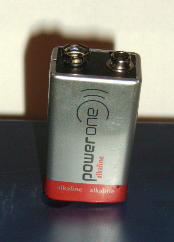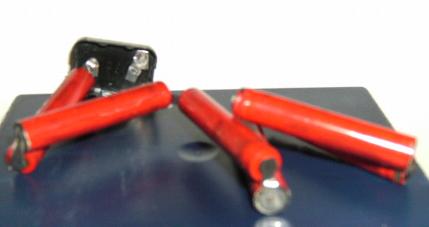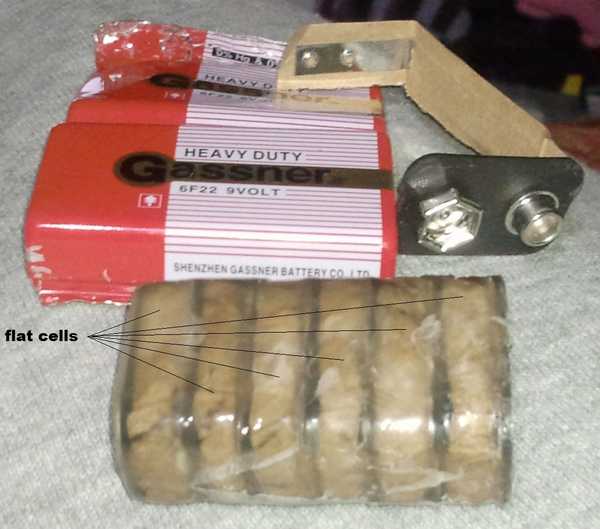General
So many manufacturers are now making battery operated equipment (or battery backup for memories etc.) that the use of battery (or more properly cell in most cases, I will use "cell" and "battery" interchangeably here, as is common useage) names is becoming confusing!
This confusion is because of the practice of manufacturers to assign novel names and numbers to their batteries, disregarding common, colloquial, IEC, and ANSI naming conventions. Often this is done to steer customers towards a specific brand, and away from competing or generic brands, by obfuscating the common name. For example, if a remote control needs a new battery and the battery compartment has the label, "Replace with ND65V type battery," many customers will buy that specific brand, not realising that this is simply a brand name for a common type of battery (in this case the common PP3, a simplistic example as you would probably recognise that type straight away).
Often manufacturers will change slightly the battery code number, for example: a 301 type button cell is also called, D301, GP301 and V301. These numbers with the different prefixes are all the same cell. Other manufacturers have called this same cell: 1132SO, 1133SO, 226, 260, 280-01, 280-41, AG12, D, D226, D260, D386, G12, GS12, H, LR43, S1142E, S04, S07, SB-A8, SB-B8, SP301, SP386, SR43, SR43SW, SR43W, SR1142, V226, V386! So that's over 30 different numbers (and more as I discover them) for the same battery!
Not all "Equivalents" are the same
Sometimes there is a slight variation in the battery between manufacturers, for example the CREATIVE NP-60 and Fuji NP-60 are interchangeable and, therefore, equivalent but the Fuji NP-60 is rated at 1050 mAh, while the CREATIVE NP-60 is 1150 mAh, a whole 100 mAh more. Always check specifications for your best deals.
Chemistry
Some battery chemistries, i.e. Mercury, are no longer produced due to their toxicity and I have tried to include them with the nearest replacement. The replacement type should physically fit but you may notice reduced usage times or other effects.
Batteries that are "equivalent" may use a different chemistry make-up, which may make them more expensive on the face of it but can be a saving in the long term:
- Zinc, Zinc-Carbon, Carbon-Zinc. Low energy density but inexpensive to produce. Suitable for low power devices such as clocks etc.
- Alkaline. Higher energy density than Zinc but more expensive. Better suited to higher drain devices such as torches, radios, CD players etc.
Low power option for watches (no lights) etc. - Silver Oxide. Good energy density, used in small, high power devices such as watches (with lights), LED torches, Laser pointers etc.
- Lithium. Really high energy density. Excellent for high power devices such as digital cameras, flash guns etc.
- Mercury (no longer produced). Very stable voltage (1.35v) throughout life. Now illegal due to toxicity.
- Zinc-Air. Very stable voltage (1.4v) throughout life. Used mainly in hearing aids but also being produced in different sizes to power things that required Mercury batteries (due to voltage stability) previously.
"Unobtanium" & Obsolete Batteries
I have included, where possible, older and obsolete types of batteries that are no longer in mainstream production. There are some small companies still making replacements of some types to keep older equipment, AVOs, radios etc. working and it is just as important to find the correct fitment. You will also find hints and tips on how to easily replace a battery that is no longer available, that type of information is in the details pages.
Usage Time
Another point to note, especially with the AA, AAA, C, & D "standard" consumer type batteries:
Many "unknown" brands (most originating from Asia, you know, the country that has a name that tea cups are made from!) are being sold in "£" shops (UK) and other "discount" shops for "not a lot of money for many batteries".
I have had complaints from family and friends that battery operated items (can openers, baby toys etc.) are "broken" - a new battery (or batteries) were only fitted last week and "it has stopped working", can I look at it and fix it?
All "failures" such as this have been because of the really cheap batteries! Many of these "cheap" brands (including supermarket own brands), when chemistry type is mentioned, say "Zinc" or "Zinc - Carbon". Zinc "technology" is probably the lowest energy density (power per gramme) of all the battery chemistries used in consumer batteries also, to save on manufacturing costs, there is as little chemical used as possible (in the "Asia" ones, supermarket own brands seem to be a bit better with this). Now, I'm not endorsing any particular brand here but try this for yourself; hold a "cheap" battery in your hand, feel the weight of it, now replace with a Duracell or Energiser of the same size. Feel the difference in weight? That's because there are more chemicals in the "known brand" and chemicals equals power! (OK, Duracell and Energiser are Alkaline and, therefore, better power anyway!)
If you want to change batteries every week or don't mind your torch going out just when you need it then use the cheap batteries. If you want longer use from your kit then pay the extra, it will probably be cheaper in the long run anyway!
This doesn't really apply to the cards of watch batteries you can buy for a pound, Yes they are alkaline not silver-oxide but you can get reasonable use from these cheap batteries for not a lot of cash (unless your device is power hungry) and 5 to 15 of the same size means you don't have to pay out too often to change them!
Some notes about the ANSI / NEDA letters.
The letters after the ANSI / NEDA number have certain meanings:
- No suffix letters Carbon zinc
- A, Alkaline.
- AC, Alkaline Industrial.
- AP, Alkaline Photographic.
- C, Carbon zinc Industrial.
- CD, Carbon zinc Industrial (heavy duty).
- CS, Carbon zinc Industrial (super heavy duty).
- D, Carbon zinc (heavy duty).
- F, Carbon zinc (general purpose).
- L, Lithium.
- M, Mercury (no longer produced).
- MP, Mercury Photographic (no longer produced).
- P, Photographic.
- SO, Silver oxide.
- SOP, Silver oxide Photographic.
- Z, Zinc air.
- ZD, Zinc air (heavy duty).
Some notes about the IEC numbers
Let us look at the IEC number and voltage of 3 different batteries:
- LR6, 1.5 Volts.
- 4R25, 6 Volts.
- 6F22, 9 Volts.
Can you see a pattern? Well in the first example there is no number before the letter(s) and it is a 1.5 Volt battery. The second example has a 4 before the letter(s) and the third example has a 6 before the letters. Now a little math! 4 times 1.5 is 6 and 6 times 1.5 is 9. Now do you see a pattern?
The IEC numbering series is set so that any number before the letter(s) is how many 1.5 volt cells make up the final battery, the letters and numbers denote the cells used for the battery. Take a look at the A413 Battery, 20F20, 30 Volts (20 times 1.5? = 30 of course!). There are some exceptions in the IEC CR series but for general domestic types of battery it holds true, or at least it did until NiCd, NiMH and other chemistries came along with differing voltages.
Further to this the letters tell us something as well, this time the chemistry and shape. The first letter is chemistry, the second shape (some only have 1 letter, denoting shape):
- "C" denotes Lithium Manganese Dioxide.
- "F" (in some batteries, i e 10F20) denotes flat Zinc Chloride cell(s).
- "F" (in other batteries, usually with another letter eg: "FR") denotes Lithium Sulphur Dioxide.
- "H" denotes Nickel Metal Hydride (NiMH). Rechargeable.
- "K" denotes Nickel Cadmium. Rechargeable.
- "L" denotes Alkaline Manganese.
- "M" or "N" denote Mercury, now banned because of its toxicity.
- "R" (on its own) denotes a Zinc Chloride round cell.
- "R" after another letter denotes a round cell with the chemistry shown by the first letter.
- "S" denotes Silver Oxide.
Sometimes there is "-2" after the number, ie the Lantern 6V (Big) battery is "4R25-2". The -2 means that there are 2 sets of cells connected in parallel to double the capacity.
Let's take a quick look at the ever popular PP3, 9 volt battery. In particular a 6LR61 "version". What does the IEC number tell us? Well it's a 9 volt battery (6LR) made from AAAA size cells (LR61).
Now I just happened to have one of these on the bench as I was writing this so out came the camera and here it is before and after opening. A quick check with a steel rule and referring to the AAAA page for the size, I can confirm that the 6 cells inside the battery were AAAA size. Some PP3 types are IEC 6F22 and they have 6 flat cells stacked up inside (image below the 6LR61 pics).



The IEC CR series (Coin cells and Camera batteries).
These are Lithium Manganese Dioxide chemistry in a round (usually, some camera batteries have shaped plastic casings) package.
Since LiMnO2 cells produce 3 volts there are usually no alternate chemistries for a CR coin cell. Conversely one LiMnO2 cell can replace two alternate chemistry cells, in a 3, 6, 9, or 12 volt battery.
CR cell numbers correlate with the cell dimensions, being the diameter in millimetres (except for the extra half millimetre in some cases) followed by the height in tenths of a millimetre, this also holds true for most of the camera types as well.
Some notes about Button Cells.
- AG series are Alkaline chemistry and provide 1.5 volts, dropping to about 0.8 volt at the end of their life.
- LR series are Alkaline chemistry and provide 1.5 volts, dropping to about 0.8 volt at the end of their life.
- MR series were Mercury chemistry and provided 1.35 volts and were stable until end of life. These are now banned.
- MRB series are made by a company called WeinCELL and are a Zinc Air voltage compatible replacement for the Mercury cells.
- SR series are Silver Oxide (Ag2O) chemistry and provide a steady 1.55 volts to end of life.
Since there are no "common" names beyond the AG designation, many places use the LR and SR terms interchangeably, and they will both fit and work. The only difference is that the SR series typically have 50% greater capacity than the LR series. In low-drain devices like watches (without lights) this isn't very important, but in high-drain devices like novelty key chain torches, or laser pointers the SR type is preferred. Typically SR and LR will be around the same price so there is no reason not to get the SR version. Often the free "demo" batteries that come with a device are the LR version. Having said that there are several brands of "Battery Cards" on the market that hold, typically, 30 batteries of several different sizes for around a pound (in the UK). These tend to be Alkaline batteries but, with a single battery costing £2 or more they are certainly well worth a look (check production, "use by" or card printing date to get the freshest batteries you can).
The MR series can usually be replaced by either LR or SR but some equipment is voltage dependent so an adaptor or the MRB series are really the only choices, the options are given on the battery details pages. The adaptors I have linked to are supplied by a British company called The Small Battery Company. I am not connected with this company in any way, I have, as yet, had no dealings with them either. I have used their website as one of the cross references for the equivalents and placed the adaptor links as examples of what is available. Other suppliers are available.
Important notes about the MRB series:
- They are expensive. Typically over £5.00 each here in the UK.
- You have to activate them by removing a sticky label that covers some holes, thus letting the air in, and wait for about 30 minutes until they are fully activated and ready to use.
- Once they have been activated they will "lose" power whether they are being used or not, you will tend to get 8 to 10 months or so use (I have seen as little as 6 months reported) before they "die". (Some people claim that a sticker replaced over the holes after use until next needed prolongs life).
- Due to the manufacturing tolerances for watches the Zinc Air cell is not recommended as insufficient air reaching the cell reduces performance and can cause what appears to be early failure.
I hope that this page has gone some way to helping you understand the various standards (ha ha!), markings and make-up of batteries. If only manufacturers would stop making up their own designations and all use the same amount of ingredients etc. then life would be so much easier!